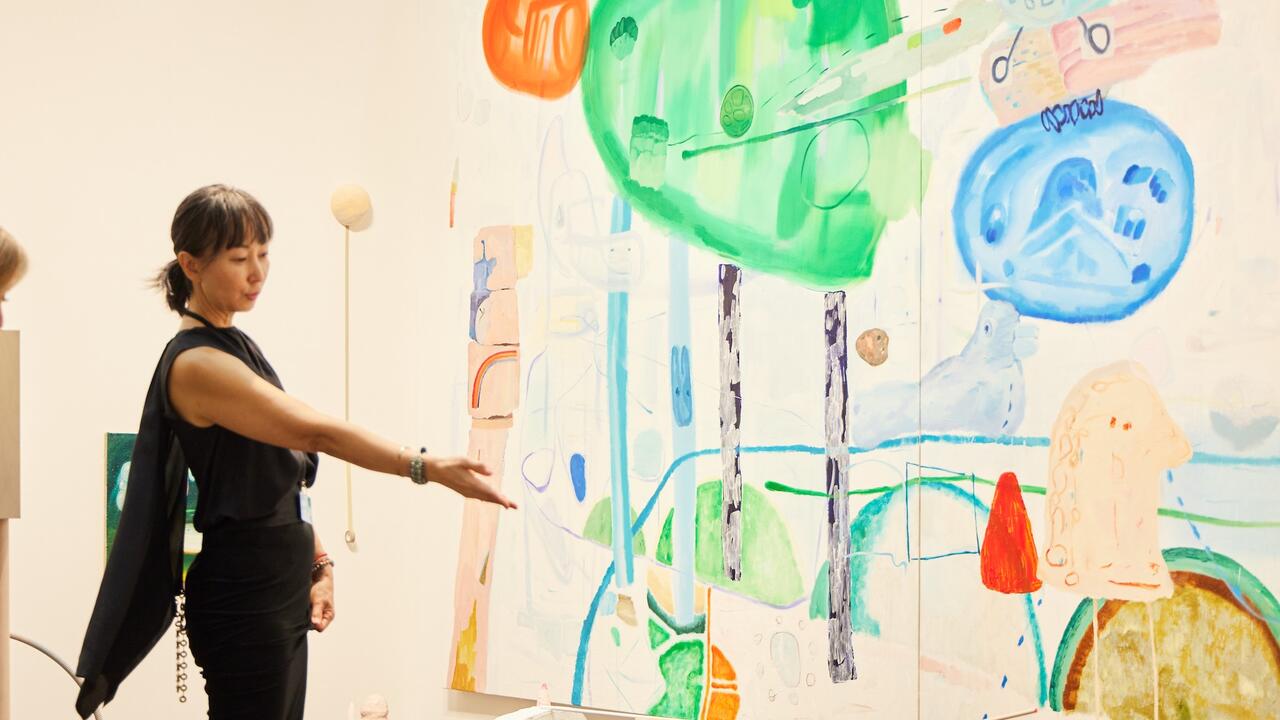Jesse Wine

Jesse Wine’s debut solo show at Limoncello presented a beguiling hybrid of conceptual gestures and a knack for handcraft. The young London-based artist completely transformed the gallery’s main space by installing a narrow walkway made of salvaged boards around its perimeter, creating a raised viewing platform a few feet above the floor. In the central depression, a field of meticulously raked gravel was punctuated by glazed ceramic forms, resembling a Japanese Zen garden, but with ceramics replacing the typical mossy boulders. Titled ‘The Practice of the Wild’, the exhibition seemed to unpack and then re-choreograph a central drama facing artists today.
Although the tradition of rock gardens dates as far back as the eighth century, their mimetic relationship to landscape, and their anticipation of a fixed viewing position assumed while meditating, arguably predicts both the visual orientation of single-point perspective in landscape painting and the photographic regime that was to surpass it as a document of place. In such a temple garden, one would be seated in a meditative pose, viewing the area as a landscape in microcosm. Wine’s installation presented itself with a canny readiness toward the inevitability of its digital documentation and subsequent uptake into a whirlwind of micro-comment, re-blogs and smart-phone reproductions lathered in readymade nostalgic filters. (To wit, I was already receiving pictures of the show in my Twitter feed on the train ride to the opening.) In Wine’s practice, however, this offering is like the disembodied grin of the Cheshire Cat; the framing mechanism’s stability is in tension with the works it presents. In equal measure to this self-aware installation, his ceramics are both deeply felt and marvellously textured objects that exhibit the artist’s strong engagement with the process of making. No mere hobbyist, Wine has been concentrating on the medium for the last couple of years and recently installed a second-hand industrial kiln in his South London studio.
In the ceramic sculptures placed within the ersatz Zen garden, the range of earthy, neutral tones in the glazes were carried by structures that were variously lumpen and bulbous. One piece, titled But What Lad? (all works 2012), had an oblong aperture on either side of its slumping conical form, revealing an internal coil structure. Another, the show’s eponymous piece, sat on a raised mound of combed gravel and appeared to be pierced by ski-shaped spears. A small, roundish work, vaguely sub-Saharan in a coppery brown and titled It’s Right Personal, sat alone and dejected. Larger basket-like structures – Fruit Bag I & II and Love and Money – were lathered in multiple layers of glaze and pushed into the corners of the garden, precariously at the points one was most likely to fall in while navigating the private-view crowds. Further engaging with the quirks of Limoncello’s basement space, one work was positioned to catch the drips leaking through a crack in the skylight. Wine’s ceramics are full of vim and swagger, an effect emphasized by the stage-like function of the platform. One couldn’t help but anthropomorphize their position in the gravel – a group of characters emerging onto an astringently prepared scene.
Wine’s insistence on skilled handcraft within his conceptual dialogue of display, gesture and circulation forces a reconsideration of some art-world clichés. Are we actually all nomadic, MacBook-wielding airport-dwellers? Or do the majority of artists still have some type of studio or other tucked away in a bad part of a big city, with insufficient heating and a friend or two dropping by, IRL? ‘The Practice of the Wild’ confronted and presented this antinomy: the salacious readiness for glamorous, ephemeral production and circulation of art-works-as-images vs. the persistently real, visceral place and practice of making those works. Wine’s dedication to this type of in-sourcing reintroduces the possibility that the contemporary artist’s subject may be read through a series of struggles and innovations within a restricted medium. Set against the Oriental aporia of the ready-to-photograph Zen garden, his earnestly worked surfaces remind the viewer that, materially, they are not post-anything – that, in a moment of embodied looking that precedes the crematorium of transmission, they share the room with fragile, imperfect sculptural bodies. An unknown object in your bagging area.
















